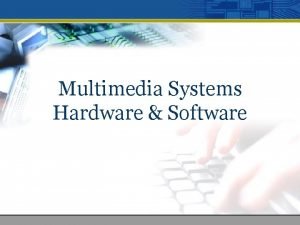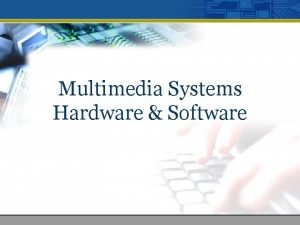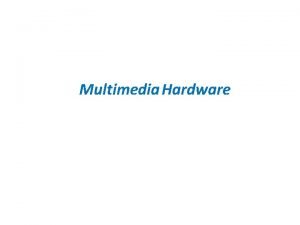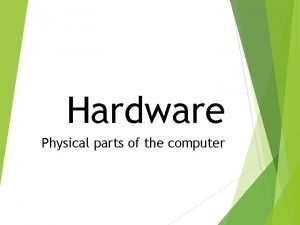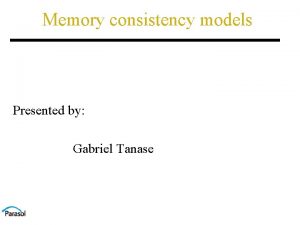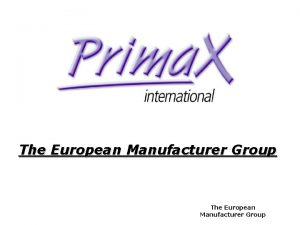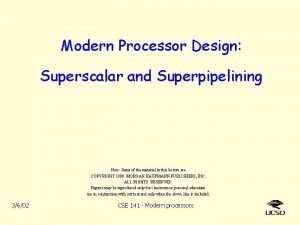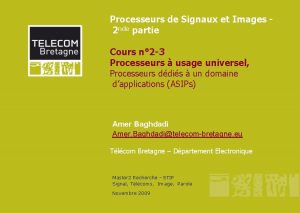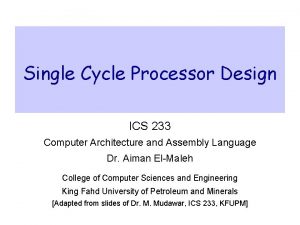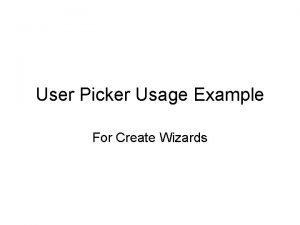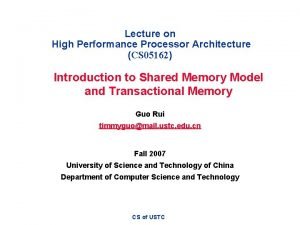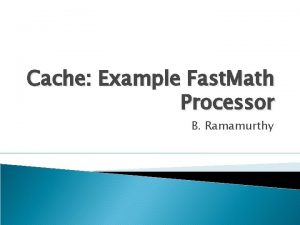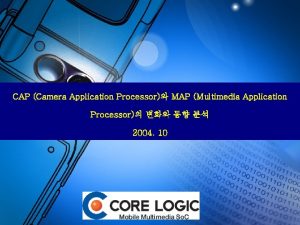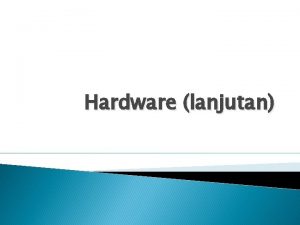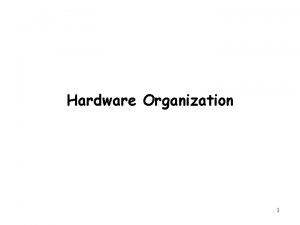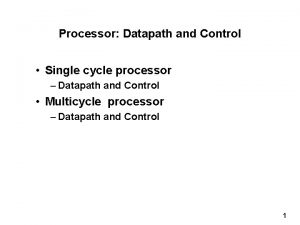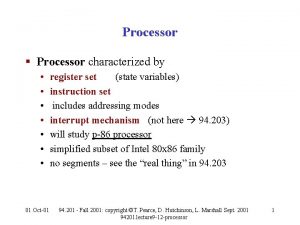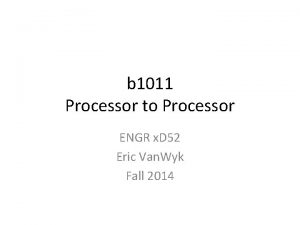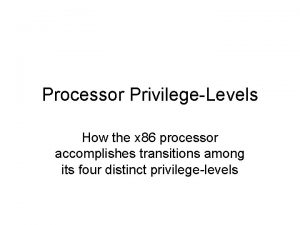Multimedia Hardware Multimedia Hardware Fast processor e g



















- Slides: 19

Multimedia Hardware

Multimedia Hardware • Fast processor Ø e. g. Pentium • Large RAM (Random Access memory) Ø Memory space that the computer uses when performing work. Ø More RAMs means computer works quicker and more efficient.

Multimedia Hardware • Storage Ø Large Hard Disk • Capable of supporting fast data transfer rate. Ø Removable large-capacity storage devices • E. g. rewritable CD-Rom, Pen drive. • A good CD-ROM burner & good CD-R software to complement it Ø Easy CD Creature Deluxe

Multimedia Hardware • High resolution and a large monitor Ø Minimum 17 inch monitor Ø A dot-pitch value of. 28 or smaller Ø Dot-pitch: distance in millimetres between each of the red, green and blue dots etched into the phosphor of the inside of the screen. Ø The smaller the dot-pitch value, the finer the image. Ø Multisync monitor: allow the change in screen resolutions without having to reset the system.

Multimedia hardware • Good video display card Ø preferable capable of displaying 24 bit colours • Good video capture cards Ø Allow you to capture video from a tape or camcorder • A good quality digital camera Ø At least support 640 x 480 pixels images Ø Has display panel Ø Use disk or card to store the images before being uploaded to the computer

Multimedia Hardware • Input devices Ø Keyboard, mouse, track ball, touch screen, graphic tablet • A good flatbed scanner Ø 24 bit colour depth and 300 -dpi resolution • Colour Printer • Colour projector

SCSI and IDE

SCSI-(Small Computer System Interface) • SCSI is a set of standards for physically connecting and transferring data between computers and peripheral devices. • The SCSI standards define commands, protocols and electrical and optical interfaces. • SCSI is most commonly used for hard disks and tape drives, but it can connect a wide range of other devices, including scanners and CD drives, although not all controllers can handle all devices. • The SCSI standard defines command sets for specific peripheral device types.

SCSI-(Small Computer System Interface) • SCSI is an intelligent, peripheral, buffered, peer to peer interface. • It hides the complexity of physical format. Every device attaches to the SCSI bus in a similar manner. • Up to 8 or 16 devices can be attached to a single bus. There can be any number of hosts and peripheral devices but there should be at least one host.

IDE-(Integrated Drive Electronics) • Integrated Drive Electronics also known as Advanced Technology Electronics(ATA) connections. • They are typically only internal, and they connects hard disks, CD-ROM drives and other peripherals inside the computer.

IDE-(Integrated Drive Electronics) • A PC motherboard can have two IDE controllers and each of them can support two devices one of which is master and the other slave. • We can install a combination of four hard disks, CD-ROM drives, or other devices in our PC, with IDE.

IDE-(Integrated Drive Electronics) • Types of IDE Ø Plain IDE, transfers data at 2. 5 mb/sec. Ø EIDE(Enhanced IDE), transfers data at 16. 6 mb/sec. Ø Ultra IDE, transfers data at 33 mb/sec.

Multimedia MCI

Multimedia MCI • MCI control enables a program to interact with any multimedia device connected to the computer that supports Media Control Interface (MCI)- which is a standard for controlling multimedia devices • Example of this devices: MIDI sequences, CD-Rom devices, audio players, video disk players…. .

• MCI control is an Active. X component you should add it to your project before using it • The control provides a series of buttons that corresponds to typical buttons on a multimedia device such as a CD player or a VCR

MCI control property and events • Command A string that specifies the command To execute Close, Play, Pause, Stop, Back Prev, Next, Seek, Record, Eject • Device. Type • Shareable a string that specifies the type of the Device AVIVIDEO, CDAUDIO, DAT, DIGITALVIDEO, MMOVIE, WAVAUDIO OTHERS Determines if the device can between Applications (true/false

• Track. Lenght • Tracks • Update. Interval • Wait • button. Enabled • button. Visible Specifies the current track Determines the length of the current Track Specified by the Track property Specifies the total number of tracks Specifies the number of milliseconds Between calls to the status. Update Event procedure Determines if the next MCI command Should complete before returning Control to the application (true/false) Determine if a button on the control is Enabled or disabled (True/False) Determine if a button on the control is Visibel or invisible (True/False)

Events • Status. Update • button. Click • button. Completed • button. Got. Focus • button. Lostfocus • Done Called at fixed intervals specified by The Updata. Interval to allow an Application to update the display And inform the user about the current Status of the MCI control Called when a button on the MCI is Clicked Called when a command is complete Called when a button becomes the Active button Called when a previously active Button becomes inactive Called when the current command complete

 Example of acid-fast bacteria
Example of acid-fast bacteria Acid fast and non acid fast bacteria
Acid fast and non acid fast bacteria External and internal hardware
External and internal hardware Hardware for multimedia
Hardware for multimedia Multimedia hardware and software
Multimedia hardware and software Multimedia hardware devices
Multimedia hardware devices Multimedia becomes interactive multimedia when
Multimedia becomes interactive multimedia when Linear and nonlinear
Linear and nonlinear Csc 253
Csc 253 Esa multimedia.esa.int./multimedia/virtual-tour-iss
Esa multimedia.esa.int./multimedia/virtual-tour-iss Coherent accelerator processor interface
Coherent accelerator processor interface Cpu hertz
Cpu hertz Sequential consistency
Sequential consistency Argostat
Argostat Embedded processor market
Embedded processor market Superpipelined processor
Superpipelined processor 8 bit processor
8 bit processor Ics 233
Ics 233 Image picker
Image picker Principles of high-performance processor design
Principles of high-performance processor design



